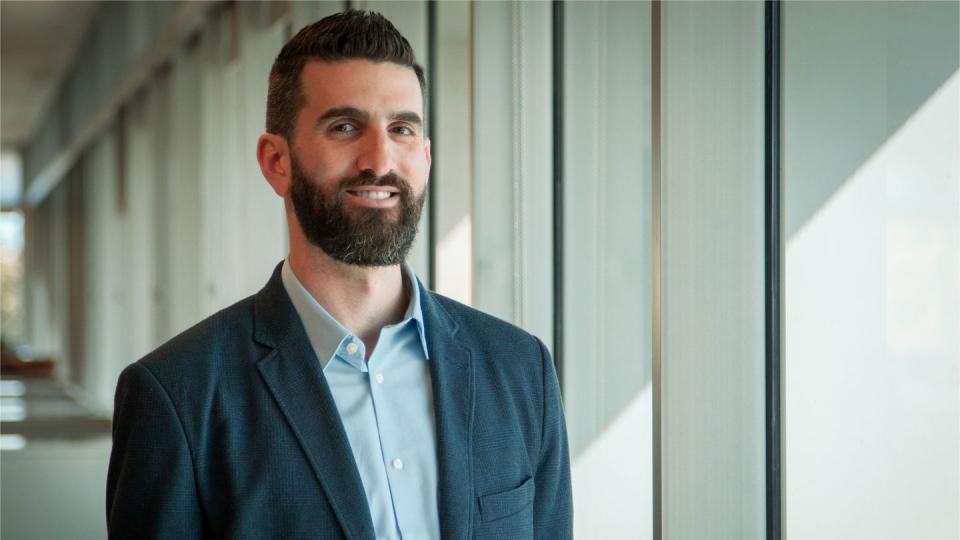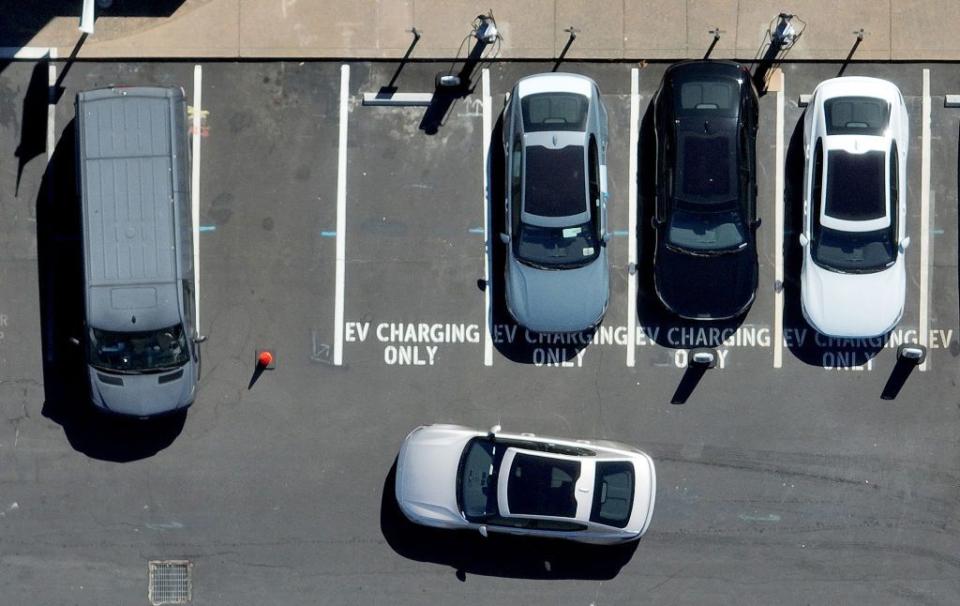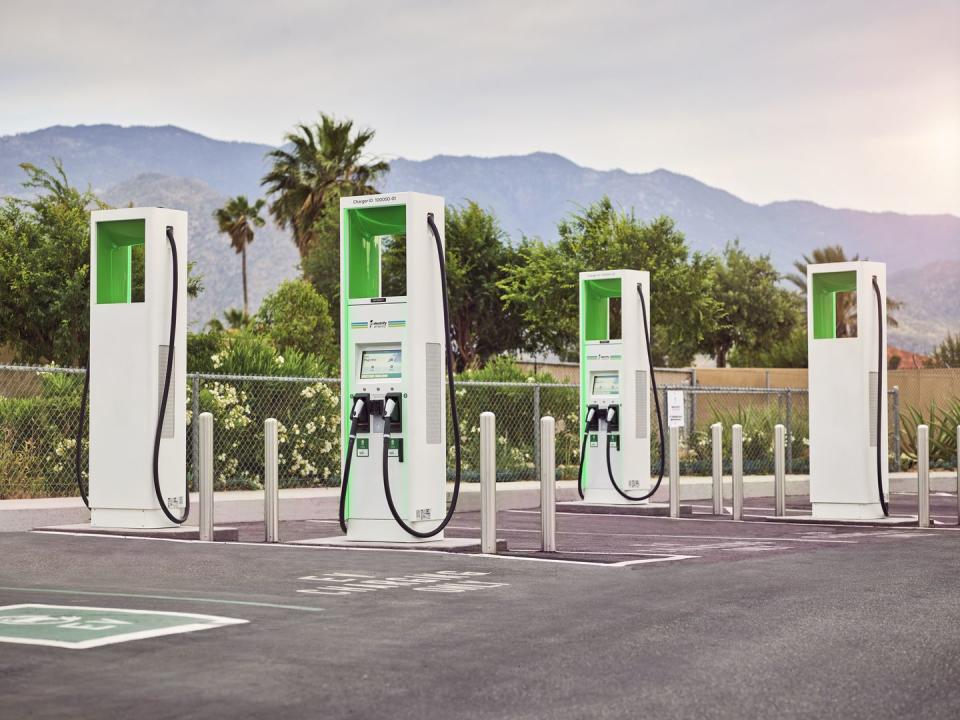Ionna Execs Expand on Plans to Build a 'Better EV Charging Experience' in the U.S.

Ionna—a new U.S. charging network backed by seven automakers—earlier this week announced its HQ location, and we've now interviewed its CEO Seth Cutler.
Ionna's chief product officer Ricardo Stamatti also spoke with us, and the two execs expanded on plans to build a "'better EV Charging Experience' in the U.S.
They said a slew of news is coming soon; they also expect the first Ionna sites to open this year, promise well-lit canopies, and contemplate on-site staff and owning sites.
Announced a year ago by a group of seven automakers, the Ionna charging network for EVs has stayed all but invisible—until now. The company announced only its name and CEO in February and this week said its headquarters will be in Durham, North Carolina.
Car and Driver spoke to CEO Seth Cutler (pictured above) and chief product officer Ricardo Stamatti about Ionna’s plans to get to 30,000 high-speed EV charging cables by 2030, located in both highway corridors and urban hubs. It’s an ambitious goal that would catapult Ionna into the small group of large North American EV charging networks: Tesla’s Supercharger network (now opening to other makers’ EVs), Electrify America, EVgo, and a few others.
Cadence of News Coming Soon
Cutler and Stamatti both stressed their “musts” were reliable, convenient stations and a pleasant user experience. It will be, they said, the “overall customer experience beyond just the charging” that differentiates Ionna from other networks.
“I told other people, we put people on the moon, in six years or so,” Cutler said. “We should be able to make EV chargers work, right?” That has to be a given, he said. It’s the value of what happens while the car is charging, the ambience, the amenities. After all, “restaurants don’t advertise, ‘You won’t get sick here,’ right?”
The Ionna execs remained cagey about most details, but pledged we’ll see a regular cadence of announcements during the rest of 2024 starting “very soon.” Last year, a source told Charged EVs, "The goal is to have six to 10 charging cables capable of 350 kW at each, sheltered from the elements, in safe, well-lit locations."
Among the details Cutler and Stamatti covered:
First Sites to Open This Year: “We have acquired a significant number of sites” in the short time since Cutler arrived in February, Stamatti said. Some are in permitting, some are in design, and Ionna anticipates starting construction over the summer—to have sites live before the end of the year. How many? Both execs were tight-lipped, but promised further info to come, including on one or more “flagship” locations that will clearly demonstrate how Ionna plans to differentiate itself from other EV charging networks. One is offering both CCS and NACS connectors from the start; another is support for the Plug & Charge plug-in-and-walk-away protocol in all EVs that use it.
Prominent Locations: “We will not be at the back of the lot,” Cutler said firmly. “We’ve turned down sites that would be otherwise be excellent—good partners, good locations—because we couldn’t be close enough to the front entrance.” Ionna already has a “significant number of sites” identified, with a few retail partners that will provide the right experience and location. “It’s a lot less about early adopters now, who are willing to tolerate certain conditions, because they’re enamored by the technology.” Mass audiences will be much more critical and less willing to tolerate any part of the experience being difficult, unpleasant, or anxiety-inducing.
Canopies, Lighting: Every Ionna site will have a well-lit canopy, Cutler pledged. While gas-car drivers take for granted they’ll be protected from rain, sleet, and snow, the canopies over gas pumps aren’t actually to protect drivers while filling up. Instead, they house the gear required to extinguish gasoline fires below—but they serve the valuable purpose of keeping drivers dry.

To date, EV drivers haven’t had the same, meaning unhappy drivers may have to scan a screen on the charging station in the pouring rain, in a dark or poorly lit Walmart parking lot, at midnight. It’s worth noting a canopy also allows large, visible branding—to reinforce to non-EV drivers that EV charging exists at all, something they’re largely ignorant of.
On-Site Staff: Every gas station has at least one person somewhere inside the building, unlike some in Europe. Cutler and Stamatti declined to discuss plans for staffing, but didn’t rule out the idea some Ionna sites could have a full-time assistant to problem-solve for patrons and address issues in real time. That would be a big improvement over state-of-the-art EV fast-charging sites today, almost all of which tend to be self-service. Drivers navigate to the station, plug in or activate a session via app, and that’s that.
Multiple Cables, Future-Proofing: Tesla commonly installs a dozen or more charging cables at its Supercharger sites, and its largest U.S. site in Harris Ranch, California, has 98 cables. Ionna’s sites will vary in number of cables provided, Stamatti said, and they may launch with fewer chargers than they will have in the end.
But their sites will be “future-proofed,” meaning infrastructure, cabling, and even electrical supply will be sized for the final number of stations, even if it opens with a lower number. What’s the minimum? “Not two, not four,” said Cutler—which suggests the likely minimum footprint is probably six or eight charging cables. Then more can be quickly added as usage warrants.
Owning Sites: Ionna may buy some sites for its charging locations outright, rather than leasing them as the majority of EV charging networks do today. That will give it more control over siting, signage, staffing, and a host of other amenities. Neither executive would give details on when, where, how much, or which conditions … but site purchase was a surprise to us.
Reliability and Profit: Cutler stressed that Ionna differs from other networks in its funding. He wouldn’t discuss the total dollar commitments by its seven shareholders— two U.S. members, GM and Stellantis; two German makers, BMW and Mercedes; two Korean members, Hyundai and Kia; and one Japanese maker, Honda—beyond saying it was a “significant investment and commitment.” Having reluctantly recognized the compelling need to offer a better charging experience for EV buyers themselves, those makers do not expect the high level of financial return from Ionna that the venture capitalists and other backers of competing networks will. Also, Ionna is not dependent in any way on funding from the National Electric Vehicle Initiative (NEVI) program administered through each state.
The times may be on Ionna’s side. Stamatti noted the number of EVs on U.S. roads will grow far more rapidly from now to 2030 than it did in the earlier years of EV sales. That means its stations can get to profitable levels of utilization quicker than those of competitors (outside Tesla and its Supercharger network) that were established five or more years ago. Their utilization levels remained low for years.
Fury at Electrify America
Recent data shows the reliability of all public EV charging networks has risen over the last year. But setting aside the Tesla Supercharger network—usable only by Tesla drivers from 2012 until earlier this year—DC fast-charging networks simply weren’t reliable enough to avert charging anxiety among EV drivers on road trips.
From the start, established automakers had zero desire to get into the business of setting up fast-charging networks for their EV buyers as Tesla had. Charging networks required multiple skills they didn’t have, from negotiating with land owners and electric utilities to thinking through a customer experience that blended software, high-power electric charging, and public hardware tough enough to resist the same vandalism as your average vending machine.

Seven years ago, it seemed the problem was solved: Electrify America was announced, funded by Volkswagen Group to settle its massive Dieselgate scandal. But by last year, it was clear that network focused first on keeping the regulators happy. To customers, it appeared reliability, customer experience, and rapid responses to user issues were strictly secondary. Anger among EV makers at Electrify America finally reached a boiling point—and the idea of a jointly created charging network jelled at last. It had been doggedly pursued in North America by BMW and Mercedes-Benz along the lines of Europe’s successful Ionity network, created in 2017 by five automakers.
Before the end of 2024, North American EV drivers will start to see whether Ionna delivers on its lofty goals and its commitment to reliable, pleasant on-road charging. Further expansion of the reliable and ubiquitous Tesla network seems less certain now than it was before CEO Elon Musk axed the entire 500-person Supercharger group at the end of April. So Ionna may not come a moment too soon—and the carmakers funding it know it has to be right if they are to sell the volumes of EVs they’ve tooled up for.
It will take a few years before EV drivers can judge whether the new network equals Tesla’s or perhaps—if sites with staff, toilets, lounges, snacks, and other amenities are plentiful—even outdoes it. Meanwhile, those well-lit canopies promise a very good start.
You Might Also Like

 Yahoo Autos
Yahoo Autos 